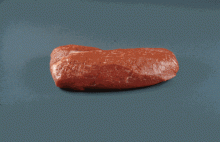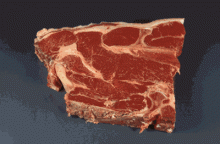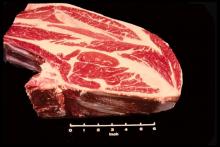Beef Meat Identification
Scroll below the carcass image to view the different cuts from this primal. Click on the thumbnail to enlarge any photo. To select a new primal, select a new primal area on the carcass or go back to choose a new species.
double left arrow icon Back to choose a speciesChuck Eye Roast, Boneless
Meat Cut: Chuck
Cooking Method: Dry/Moist
Description:
This cut consists of the Longissimus Dorsi, Spinalis Dorsi, Complexus, and Multifidus Dorsi muscles.
This cut consists of the Longissimus Dorsi, Spinalis Dorsi, Complexus, and Multifidus Dorsi muscles.
Mock Tender Roast
Meat Cut: Chuck
Common Names: Chuck Eye, Chick Fillet, Chuck Tender, Medallion Pot Roast, Scotch Tender, Fish Muscle
Cooking Method: Moist
Cooking Recommendation: Braise, Cooking in Liquid
Mock Tender Steak
Meat Cut: Chuck
Common Names: Chuck Eye Steak, Chuck Fillet Steak, Chuck Tender Steak, Fish Steak
Cooking Method: Moist
Cooking Recommendation: Braise, Cooking in Liquid
7-Bone Pot Roast
Meat Cut: Chuck
Common Names: Chuck Roast Center Cut, 7-Bone Roast, Chuck Flat Cut
Cooking Method: Moist
Cooking Recommendation: Braise, Cooking in Liquid
Arm Pot Roast
Meat Cut: Chuck
Common Names: Chuck Arm Roast, Chuck Round Bone Cut, Round Bone Pot Roast, Round Bone Roast, O-Bone Roast
Cooking Method: Moist
Cooking Recommendation: Braise, Cooking in Liquid
Description:
The Beef Chuck Arm Roast is identified by its thickness as a roast, the large round bone in the center of the cut and the many small muscles of which it is made. This roast may or may not have a cross cut rib bones showing but if present would be at the bottom of the picture.
The Beef Chuck Arm Roast is identified by its thickness as a roast, the large round bone in the center of the cut and the many small muscles of which it is made. This roast may or may not have a cross cut rib bones showing but if present would be at the bottom of the picture.
Blade Roast
Meat Cut: Chuck
Common Names: Chuck Roast Blade Cut, Chuck Roast First Cut, Chuck Crown Roast, Chuck Roast, Blade Chuck Roast
Cooking Method: Moist
Description:
This large roast contains many small muscles and is easily identified by the blade bone located in the upper center of this cut. Note also that rib bones and a portion of the backbone are located along the lower left portion of the cut. However, these bones may be removed from this large roast before it is packaged and put in the meat counter at the local supermarket.
This large roast contains many small muscles and is easily identified by the blade bone located in the upper center of this cut. Note also that rib bones and a portion of the backbone are located along the lower left portion of the cut. However, these bones may be removed from this large roast before it is packaged and put in the meat counter at the local supermarket.





